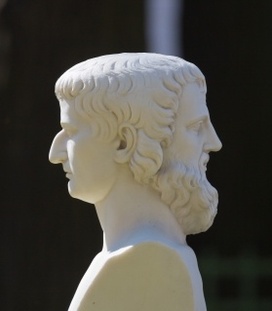 Janus statue, Summer Gardens, St. Petersburg
Janus statue, Summer Gardens, St. Petersburg Janus’ two faces looked back and forward – both over what had happened in the past as well as toward what lay ahead. It seems that there is something in human nature that tends to do this – to look back whenever we seriously look forward.
After all, what we will be and do is so often the product of what we have been and have done.
Yet this is the very attitude that the apostle Paul argues against in telling us “ … I do not consider myself yet to have taken hold of [salvation]. But one thing I do: Forgetting what is behind and straining toward what is ahead” (Philippians 3:13). There is physical evidence that this is a good idea. Despite the fact that many regard New Year’s as a time of celebration and partying, it is also, tragically, a time of many suicides each year. The reason for a great many of those suicides – where it is known – is usually not because of fear of the future, but because of discouragement and sorrow over the past.
There is certainly nothing wrong with remembering lessons learned in the past and in reminiscing on times with loved ones and good things such as blessings we have received. However, both the Bible and modern psychology make it clear that there is nothing to be gained by staring at the negatives of our past, and this is especially true at this time of year. Focusing two ways – looking as much backward as forward – is just another way of being “double minded,” which we know the Bible also tells us not to be (James 1:8).
We know the old clichés: “Focusing on the past is like driving your car with your eyes on the rearview mirror,” “If the past calls, don’t answer – it has nothing new to say,” and so on, but they really are true. While Christians, hopefully, are not at as high a risk of situational depression as many less fortunate individuals, remembering the problems of our past – all the way up to yesterday – can distract us from where we should be going. Those old Janus statues illustrate this. The face that looks back cannot see the future, and the face that looks forward cannot see the past. It’s a useful analogy to remember as we go into each new year and every new day.
 RSS Feed
RSS Feed
